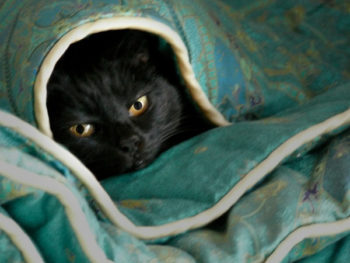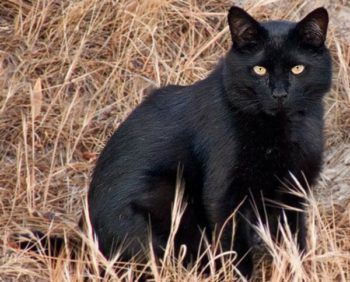Our ashram in the Santa Cruz mountains has been refuge to many creatures. Three of them were stray cats: Emma, Kitti, and Stubby. They arrived at different times, desperate for food and shelter. We welcomed these sweet feline souls, and they lived out their lives with us. Kitti was the last to go. As we watched her burial, I turned to my Guru and said, “I’m grateful to Kitti. She made me us better yogis.”
He replied, “How so?” I told him that all the ashram cats had helped us practice important spiritual principles. We learned about overcoming ego and attachment. They tapped our capacity to practice compassion. And, surprisingly, we learned about how yogis experience and overcome grief.
Arrivals of the Three Ashram Cats
The first cat to arrive was Emma. She was small and seemed frail, but she had a fierce temper. Emma had apparently been fending for herself for a long time. Gurudev took pity on her, always hunting for bugs and rodents. He suggested that we provide for her. Emma was given a continuous supply of kibble and several comfortable, warm beds. Within a few months, she was a full-fledged resident.
Later, a second cat arrived. She had a silky, black and white coat. We called her Kitti. Eventually, we learned that she was a neighbor’s cat. Kitti preferred to live with us, however. And, as cats sometimes do, she rehomed herself. Emma did not approve of this addition. The two cats remained enemies throughout their lives. Fortunately, there are two houses on the ashram property, and each cat had a place to call her own.
Then, in the middle of a cold, rainy November, Stubby arrived. A large, short-tailed cat, he was apparently abandoned and starving. Of course, we provided food, and he became a daily visitor. After a while, we earned Stubby’s trust, and he allowed us to approach him. He was the biggest of the three cats, but he was the gentlest. Stubby’s size and demeanor made us imagine him as a reincarnated yogi.
Following are some of the lessons we learned from these cats during their ashram lives.
Lessons About the Ego
As spiritual aspirants our greatest enemy is the ego—the sense of “me” and “mine.” The ego is the selfish part of our personality. It’s always watching out for Number One. It constantly thinks, what about me? When we feel more important than others, our ego is active.
Cats are especially suited to help us to set aside our egos. They remind us that our sole purpose is to provide for their welfare. We shouldn’t expect anything in return for our service. If a cat happens to grace us with a nudge, a purr, or a lap warming, then we should be grateful. They are gifts of cat grace.
Cats teach us responsibility and discipline by insisting that their needs come first. They decide when things should be done, and they’ll put your devotion to the test. Our indoor-outdoor cats had us trained to open doors any time they were near doors. Often we’d stand waiting with a door open, only to be ignored. Sometimes they’d look at us as if to say, “Who asked you to open that door?” Or, if it’s time for a petting session, nothing on our agenda had a higher priority. (Try to work at your computer when your cat wants something. She seems to know that walking—or sleeping—on your keyboard will get your attention.)
By serving others we’re released from the bonds of ego. The yogi can exercise service by strict obedience to the cat’s will. Peace follows quickly when this lesson is learned.
Lessons About Compassion (Ahiṁsā)
All living creatures, animal and human, give us opportunities to grow in spirit. We practice compassion by putting another’s welfare before our own. Interestingly, the compassionate giver benefits more than the receiver:
“Undisturbed calmness of mind is attained by cultivating friendliness toward the happy, compassion for the unhappy, delight in the virtuous, and indifference toward the wicked.” – Patañjali’s Yoga Sūtras (I:33)
Each of our ashram cats joined us following an unfortunate past. Emma’s temper hinted at the reason for her homelessness. She could be easily annoyed. We had scratches and bite marks to show for it. But we were patient, and eventually Emma learned that she was safe and loved. Her angry outbreaks diminished over the years.
Kitti evoked compassion with her pretty face and soulful mew. She was easy to love. Stubby, despite his size and strength, demonstrated compassion. He was tolerant and patient with the other cats. Being the last to arrive, they often harassed him. But he took it stoically and only hissed or swatted when they became intolerable.
Lessons About Attachment
When we want to possess something, it’s called a desire. If we have something but are unwilling to lose it, that’s called attachment. Both desire and attachment are obstacles on the spiritual path. They disturb our peace of mind. Without peace, we suffer.
Physical attachments are easy to see. You might think, I love my new diamond ring. If I lose it, I’ll be devastated. But yogis are more concerned with mental attachments. These are less obvious and more insidious. Practicing non-attachment is an ongoing part of a yogi’s practice.
“In order to reach the state of perfection or liberation, you should live a life of non-attachment, doing what is appropriate in every situation as it reaches you. Rest assured that this is the vital factor in the teachings of all scriptures.” – Yoga Vasishtha
We’re often more attached to our pets than we think. We might care for them dutifully and compassionately. But when they leave us, the depth of our attachment is revealed. This is often the case on the spiritual path—simple, daily life tests your innermost feelings.
Emma was lost to Nature. Old and feeble, one day she didn’t return home after her evening walk. I still regret the lack of closure felt in not being able to say goodbye. Kitti and Stubby benefited from this lesson. We kept close tabs on them, making sure they were safely indoors before dark.
Stubby’s stoic personality won my heart even before he moved in. As a strong, male cat, he fiercely defended his territory. Stubby often came home with deep scratches and bite wounds. Proud as he seemed over his conquests, his encounters led to many veterinarian visits and difficult house arrests. During his most active years, I was acutely aware of my attachment to Stubby. I feared for his safety. In the end, it was bone cancer that caused his death. All that worry and fear had been unnecessary. The cancer was out of my control.
Kitti, our last to go, had chronic feline kidney disease for many years without symptoms. When symptoms appeared, we worked to make her comfortable. Kitti’s treatment plan included sub-cutaneous fluid injections. At first these were once or twice a month. Eventually, we were injecting her every day. We did this for months until Kitti finally told us that she’d had enough. Her quality of life had diminished, and she wanted to be left in peace more than anything else.
In all these cases, our sense of duty and compassion led us to care for the ashram cats. Each of them brought joy into our lives for years. But, to the degree that we were attached, we experienced suffering when it was their time to leave us.
Lessons About Grief
Accepting the experience of grief was an important lesson learned from our cats. With each loss I recalled these verses from the Bhagavad Gita:
To that which is born, death is certain, and to that which is dead, birth is certain. You should not grieve over the unavoidable. (2:27)
The Self, which dwells in all bodies, can never die. Therefore, you should not mourn for any creature. (2:30)
I was surprised and confused by the grief I felt when our kitties left us. As a yogi, I had expectations of being superhuman. I’d almost forgotten that grieving is a natural part of being human.
But there’s a difference in a yogi’s grief. The yogi sees grief as one of many emotional experiences—charged thoughts—that pass through the mind. We witness grief just as we would any other thought.
By witnessing a thought, we can remain separate from it. Then we can release the thought and move on. Tears might be shed, and that’s okay. This process is repeated until it’s no longer needed. A yogi’s daily meditation practice helps speed emotional healing.
Moving On
Yogis believe in reincarnation. As spiritual beings we are constantly evolving. Eventually we become enlightened. Eastern scriptures tell us that animals evolve by their association with humans—just as we evolve through holy company. I’m comforted by this knowledge when I remember our cats.
Yogis may perform a ritual to help the passing of a loved one. I did this ritual for each of the ashram cats. I trust that Emma, Stubby, and Kitti have been reborn into human families. I enjoy thinking that they are loved. They will not know hunger again, and they are on the path to becoming enlightened beings.
Every yogi should have a cat at some point in his or her spiritual quest. Cats teach us the lessons of egolessness. They give us daily opportunities to practice compassion. Cats help us to see how attachment affects our inner peace. And, finally, we learn how to acknowledge our grief and move through it.
Acknowledgements
Several people and organizations helped us become better cat caretakers. I recommend them wholeheartedly:
- Beneath the Redwoods Mobile Vet: Dr. Steve Egelhofer and his assistant, Beth, who also happens to be his wife, visited our home countless times from Emma’s arrival to Kitti’s euthanasia. Dr. Egelhofer and Beth are the most compassionate and caring people I’ve ever met. Their expertise, consistent support, and professionalism over many years were outstanding.
- Tanya’s Feline CKD Website: The information and support given by this website is essential if your cat suffers from chronic kidney disease (CKD). Your veterinarian might not specialize in CKD. In that case, you must do much of your own research and then work with your vet to provide the best care for your cat. A support group is offered through the site. It’s a priceless resource for cat owners dealing with CKD.
- Cat House on the Kings: When Stubby’s personality and consequential injuries seemed too much for us to manage, we considered rehoming him. That’s when I discovered this organization. I realized that many people don’t try hard enough to find solutions for their cats’ problems before abandoning them. We worked harder, and Stubby settled in. It was worth the effort.
- I invite you to watch this video about Cat House on the Kings. It will warm your heart to see the dedication of this no-cage, no-kill shelter. And it’s a perfect example of one woman’s lifetime dedication to the practice of compassion: (https://youtu.be/R4u41ysH3eE:)
Chityānanda has been a disciple of Svāmī Gurupremānanda Sarasvatī since 1975. She teaches meditation and yoga as a spiritual path in Santa Cruz, California.




I really enjoyed reading this posting. There is much to learn from what you said about how taking care of a cat can cultivate this need to relinquish your ego.
Please forgive me for just now making a comment. I did read earlier, but finally have a moment to do a reread and acknowledge what you wrote.
Thank you for your comment, Nakisa. I think that if we look for lessons in life we can find them everywhere. Our kitties were especially good teachers! Namaste.
Appreciating the commitment you put into your site and in depth information you provide.
It’s good to come across a blog every once in awhile that isn’t the same out of date rehashed information. Fantastic read!
I’ve bookmarked your site and I’m adding your RSS feeds to my Google account.
Thank you for your nice comment. It’s always encouraging to learn that someone appreciates Quiet Karma and its content. I’ve been blessed with a wonderful teacher, and this is my way of sharing the wealth of yoga’s teachings that I’ve received from him. Namaste.
Thank you for this uplifting and positive story. I wholeheartedly share your beliefs and hope to visit your ashram soon.
This is something I will share with many.
Lynea Lattanzio, director
CAT HOUSE ON THE KINGS.
Dear Lynea, I’m so touched that you would take time out from your work to comment on this article. I’ve been watching Cat House on the Kings for years. Your consistent devotion to your cause is an inspiration — and it’s extremely rare in any field. You are the Mother Teresa of our feline friends. Thank you for all you do. Namaste.
Thanks for a great post, Svami. I forward on many of your posts, but this time I know 2 people in particular who will benefit. Is this ok with you?
Cats, and pets in general, teach us about unconditional love. Love that is not a business contract, where nothing is expected in return.
Thank you for your comment, James. Yes, please do forward on any of Quiet Karma’s posts to anyone who might enjoy or benefit from them. Namaste.